– CHRISTIAAN PUNTER, hifi-advice.com
In the initial NuPrime AMG review, I have focused mainly on the AMG-STA power amplifier, with the AMG-HPA headphone amp-preamp thrown in as a bonus. For this second installment, I have been sent a second AMG-STA power amplifier so that I can use a pair in mono-mode. Additionally, I have been sent an AMG-PRA analog preamplifier to round off the NuPrime system.
To summarize what I wrote in the initial review, I felt that the AMG-HPA headphone amp-preamp and AMG-STA form a compact-sized, yet powerful, versatile, and well-thought-out pre-power combination. Both the preamp and the power amp offer great value for money along with several very nice touches that belie the expectations for their respective, and collective, price range.
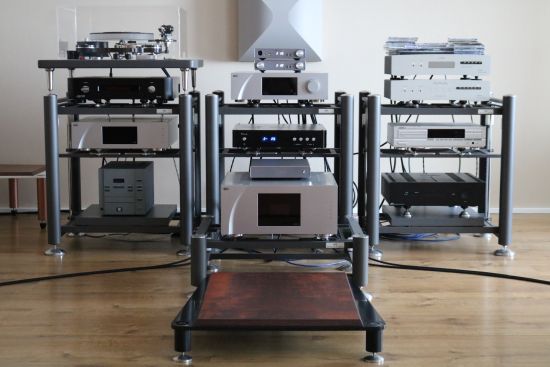
System Context
In this add-on review, I will again assess the pre- and power amplifiers individually and as a system, but in a condensed form since all the details can be read in part one. When listened to individually, this will be in the context of either the Aqua Formula xHD DAC with V2 output board along with the Audio-GD Master 1 preamp, or the CH Precision C1 DAC. The source in both cases is the Antipodes K50 running Roon via network either to the C1 DAC or via HQPlayer to the Aqua LinQ, which is then connected via AQLink I2S cable to the Aqua DAC. The loudspeakers are the Magico S1 MkII’s.
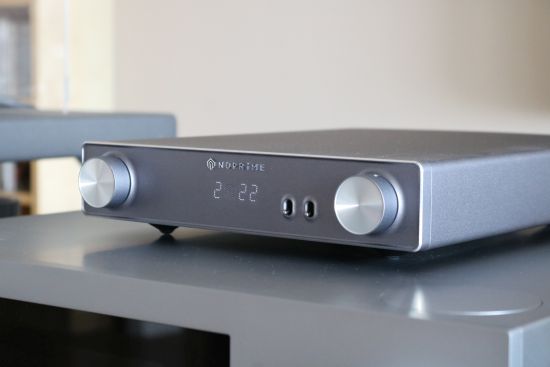
AMG-PRA preamp
The AMG-PRA analog preamp offers much the same functionality as the AMG-HPA headphone amp-preamp but instead of the headphone section offers some refinements and a user-selectable 4-stage “Active Low Frequency and Harmonic Gain” control which is essentially a four-step loudness control.
Like the AMG-HPA headphone amp-preamp, the AMG-PRA builds on a big linear power supply and uses an ultra-wide bandwidth low noise JFET, single-ended Class A input design and a MUSES8920 Op-amp along with a MUSE S72320 Digital Volume Control. At only 1.595 euro (as opposed to 1.895 euro for the AMG-HPA headphone amp-preamp), the AMG-PRA offers even better value, if you don’t need the headphone output.
The volume knob works smoothly and precisely, its micro-pore led display provides a subtle but high-contrast reading that is legible even from my listening position at 6 meters. The supplied full-metal remote control with its polished metal roller-ball buttons puts the cheap plastic affairs of many competitors, even high-priced ones, to shame.
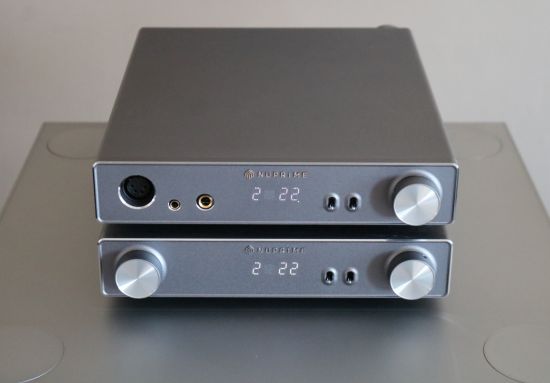
Top: AMG-HPAheadphone amp-preamp, bottom: AMG-PRA
The AMG-PRA preamp, when judged on its own, has a full and rich sound and threads a fine balance between sounding smooth and being revealing, offering great resolution without ever sounding lean or harsh. A typical expectation bias might be to expect little bass or a lean sound from a component as diminutive as the AMG-PRA but the inverse is true. This preamp sounds as beefy as the biggest specimens that I have heard.
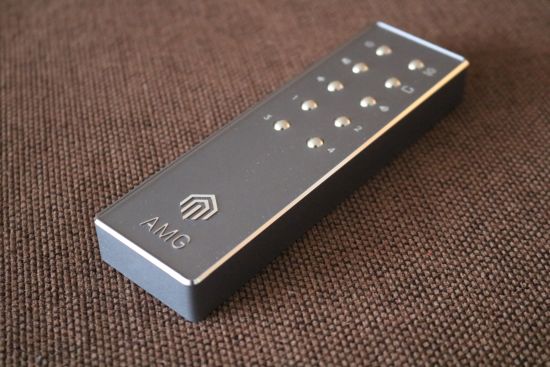
While the preamp is commendably even-handed and sounds essentially linear it is not quite as transparent nor as articulate, as the AudioGD Master 1. Resolution really is not in question but compared to the Master 1, or the C1 DAC connected directly to a power amp, the music loses a bit of vitality and urgency when using the AMG-PRA. In a way, it is a price to pay for its smooth, rich and forgiving nature.
Of course, I should emphasize that I am absolutely spoilt. The level at which I am judging these components is so far beyond what might reasonably be expected given their modest price that it’s just unfair. The thing is that the AMG-STA power amplifier is simply fantastic and that made me compare it to components that cost multiples. As logic has it, I am doing the same with the preamp. But as I have found time and again, it’s just impossibly difficult for any manufacturer to make a preamp that is 100% transparent, even if cost is not a factor. It’s not without reason that I do not use an analog preamp even though I have been in the position to hear the best of the best.
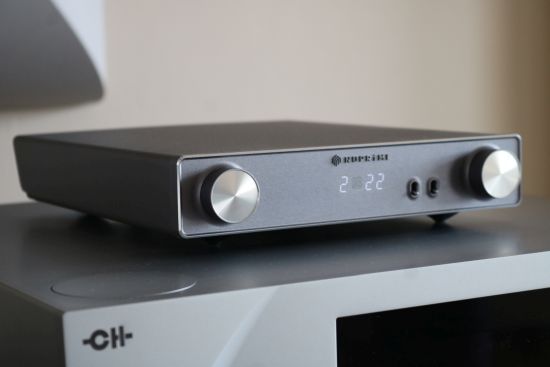
All things considered, and to be fair, the AMG-PRA preamp is likely to be used in a system with speakers of comparable cost, where its smoothness will most likely actually be desirable. And, apart from the Audio-GD, which is at an advantage due to 100% Chinese operations, I must admit that I have not heard any other preamp close to the AMG-PRA’s price range that performs similarly well.
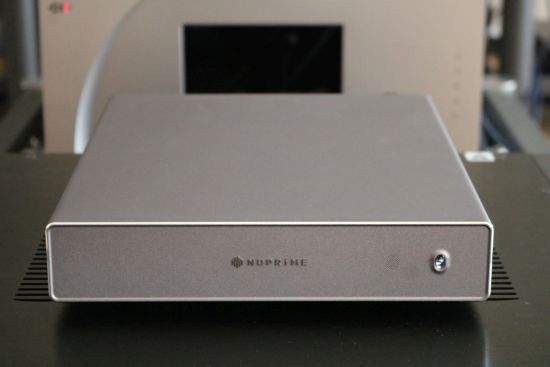
AMG-STA power amp
The AMG-STA stereo amplifier can be turned into a mono amplifier with the flick of a switch. In this mode, the right-channel input is used to feed both amplifier sides and the speaker wire plugs connect to the two plus/hot-terminals. When switched to mono operation, the amplifier’s output is raised from 2x 130 Watts at 8 Ohms to 300 Watts at 8 Ohms. Considering that I am already hugely impressed with the stereo model, how much more could doubling up bring? Well, a LOT, as it would turn out. But before I take the power amp to the max, I will start with the NuPrime combo, consisting of the AMG-PRA preamp and a single AMG-STA power amp in stereo mode.
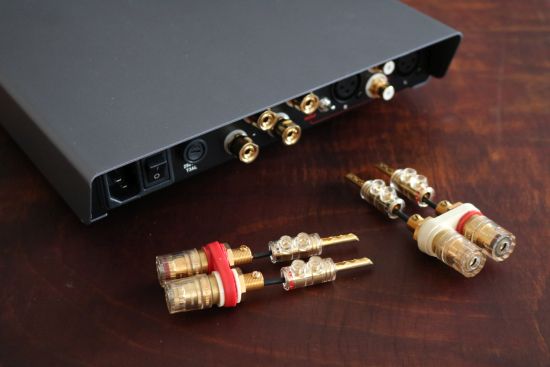
In order to be able to use the Jorma Trinity loudspeaker cables, I made a pair of custom adapters using WBT connectors and ViaBlue bananas connected via short pieces of OCC solid core wire. This assembly was then swapped in its entirety between the three amplifiers.
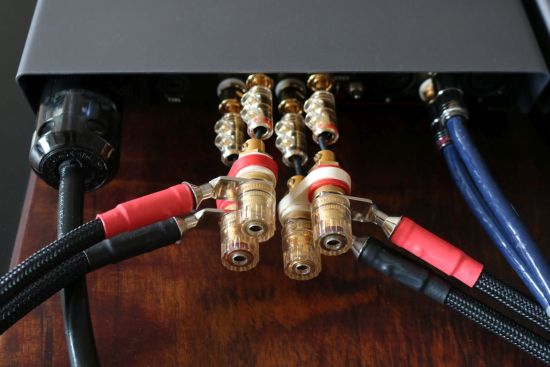
Listening
The AMG-PRA + AMG-STA form a beautiful combo, not only visually, but also in terms of sonic synergy, the preamp’s robust and full sound perfectly complimenting the power amp’s slightly leaner balance. The combined result is a musically always engaging sound that is solid and full-bodied, smooth and refined yet highly detailed and transparent, with perfect pacing, and great dynamics. Honestly, at 3200 euro, I haven’t heard a better amplifier, either integrated or separates.
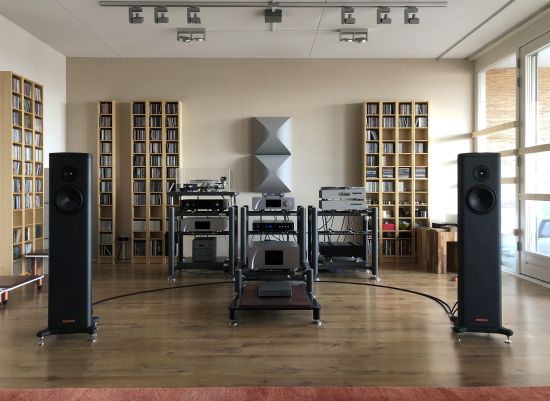
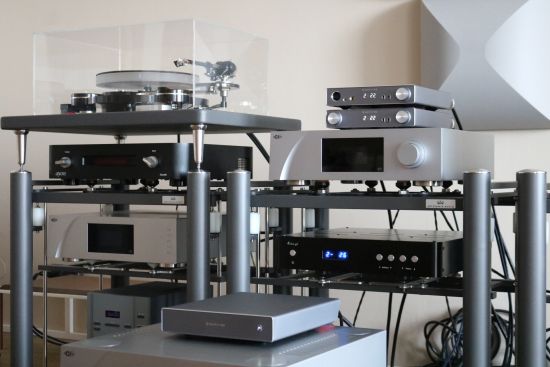
But as great as the combo is, I already mentioned that the power amplifier is the star of the show. On its own, it is capable of performing on a level that is well and truly beyond what might be expected from an amplifier at its price point. To be more precise: if the preamp already performs at a level that belies its price sticker, the power amp steals the show as it has the ability to perform on the level of amplifiers that typically cost multiples of its modest 1.595-Euro price. I am not kidding!
Double Mono
After doubling up the amplifiers (still with the C1 as a source), the sound level becomes 6dB louder. After compensating for this using the C1’s volume control, it is immediately evident that the performance is raised further across the board. When bridging an amplifier, often, you gain output voltage but not robustness and, pretty much every time that I tried it, you lose a bit of refinement and fluidity, and most importantly, an amount of musicality. I know, it’s a meaningless word, but I use it to describe that bridging can lead to a technically more capable amplifier but with a less involving sound. But that is not the case here.
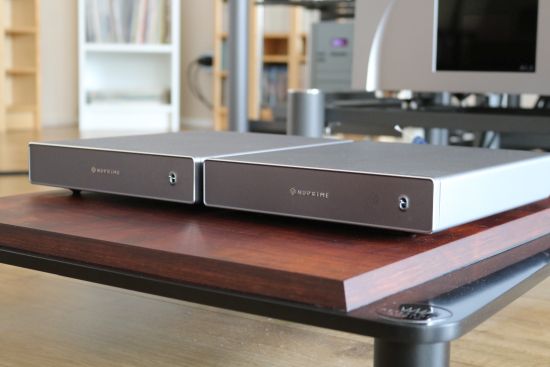
The mono’d duo sounds every bit as fluid, refined, airy and subtle as a single amp in stereo mode. The overall presentation, though, is a little different. A stereo AMG-STA has a slightly sweet, subtly relaxed presentation with a midrange and upper bass that seem just a little mellow compared to the ST-10 as well as the CH A1.5 which is my reference in terms of absolute neutrality. The mono pair sounds even more linear. Mind you, despite what I wrote above, I feel that the stereo model is already one of the most linear amps that I have heard, so this means that the mono’d pair gets even closer to the ideal that is the CH A1.5.
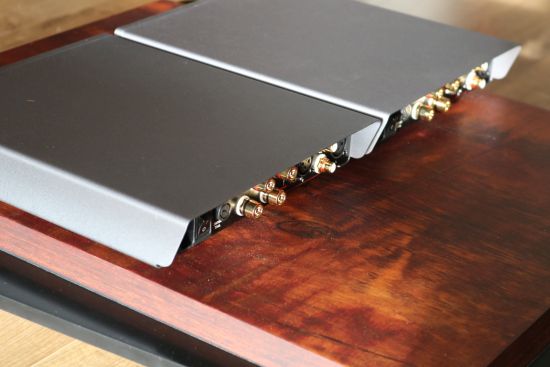
I only wished that the connectors on the rear were arranged more cleverly and more spaced out, for instance by moving the fuse to the bottom. The overlapping “flap” makes for a clean look but makes connecting large spades effectively impossible.
Along with even better linearity and transparency the bass is tighter and more articulate in its upper range. Yup, precisely the area in which the stereo model could do slightly better. Although it takes a couple of minutes to adjust to the leaner and more neutral sound, I quickly found myself hooked to the new presentation. The relaxed and slightly warm quality of the stereo mode is gone but all of the refinement is preserved. More vital, immediate, rhythmically urgent and dynamically incisive, importantly, there is no tendency to dryness nor too much control. The bass is tight but also upbeat and punchy and the presentation is highly engaging, both cerebrally as well as emotionally.
Remember that I mentioned in part 1 of this review the ST-10’s advantage over the AMG-STA in terms of midrange communication and overall timbre? Well, even these aspects are improved with the switch from stereo to mono.
Going back to a single stereo unit I can imagine some people preferring its warmer and more relaxed presentation with certain systems and speaker combinations but in an absolute sense, two units simply perform at a higher level, not only in terms of audiophile parameters but also in a musical and emotional sense. For me, it is a no-brainer: two units are simply better than one.
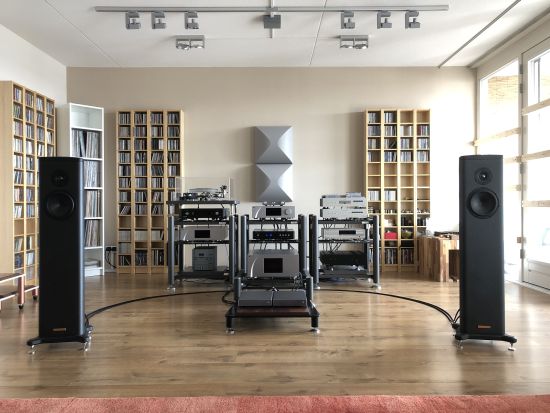
The Acid Test
In the morning, with fresh ears and after having kept all amplifiers switched on overnight, I started playback from the Antipodes K50 via the C1 as before, using the pair of AMG-STA amps switched to mono. Boy, this was really good! Vocals are pure and rich, emotionally compelling and entirely convincing and the overall level of transparency and refinement leave nothing to desire. More to the point, there was simply nothing to criticize at all. If pushed, in my mind, I could imagine the CH possibly being timbrally a little more convincing and potentially slightly more robust. But otherwise, I had to conclude that I was totally happy with this performance.
So, what would the actual switch to the A1.5 still bring? As it turned out, dynamically, the cutie AMG-STA pair and the Big Swiss do not really differentiate themselves from one another. The differences are to be found in more subtle areas. For instance, harmonically-complex sounds such as rustling drum brushes stick out from the mix just a little more clearly and decay just a little longer, suggesting a higher-res and more naturally “analog”, just slightly more realistic sound. Along with this, I notice that, indeed, the timbre is more natural and the overall feel is more organic and acoustically convincing, which is most clearly heard with piano. Here, the harmonic overtones seem less glossed over and more differentiated from one another and the overall tonality is just that little bit more wooden or steely where it needs to be to make me believe that it is an actual instrument that is playing.
By the way, the bass was one other factor in which the A1.5 outperformed the AMG-STA. Well, although the Big Swiss amp is still a little bit more solid than the mono AMG pair, the difference really is not very obvious anymore. What’s more, although the AMGs have a linear power supply they still have the kind of upbeat vividness in the bass that comes along with the switched-amp territory. And I have to say, there is definitely something to it. The A1.5 is more solid and weighty but I can’t in all honesty still say that its bass is objectively better, more just a different rendition.
I should also stress that, while ultimately justifying the CH amp’s existence, these differences are far from earth-shattering. And given the rather ridiculous price difference, this speaks volumes for the AMG-STA.
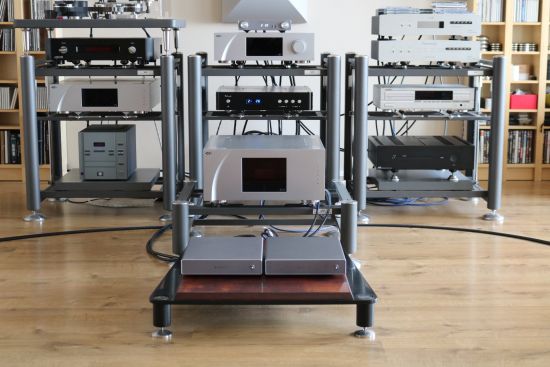
Conclusion
The AMG-PRA + AMG-STA form a beautiful combo, not only visually, but also in terms of sonic synergy, the preamp’s robust and full sound perfectly complimenting the power amp’s slightly leaner balance. The combined result is a musically always engaging sound that is solid and full-bodied, smooth and refined yet highly detailed and transparent, with perfect pacing, and great dynamics. Honestly, at 3200 euro, I haven’t heard a better amplifier, either integrated or separates.
As great as the combo is, the AMG-STA power amplifier really is the star of the show. On its own, it is capable of performing on a level that is well and truly beyond what might be expected from an amplifier at its price point. To be more precise: if the preamp already performs at a level that belies its price sticker, the power amp steals the show as it has the ability to perform on the level of amplifiers that typically cost multiples of its modest 1.595-Euro price. I am not kidding!
Combine the AMG-STA with a great volume-controlled DAC and you’ll have a nearly unbeatable system. Between single and dual amps, if ever there was a no-brainer decision, this is it. The pair simply raises the performance in each and every audiophile parameter, without harming the emotional involvement.
As should be clear by now, I am definitely impressed by NuPrime power amplifiers. First, the ST-10 proved to be a keeper, then the ST-10 Monos proved that the concept could be taken further, then the AMG-STA proved that Class-D can be as “analog” and as refined as the best linear power amplifiers, and now, the pair of AMG-STA’s have further raised the bar. Although the ST10 and ST10 Monos still have their unique flair, as of now, the pair of AMG-STA’s are my personal reference in the field of affordable power amplifiers with true high-end aspirations.
Whether used as a single stereo model or as a double-mono pair, the AMG-STA is an absolute HFA Favorite.

Link to the review -->https://www.hifi-advice.com/blog/amplifier-reviews/power-amplifier-reviews/nuprime-amg-pra-with-2x-sta-stereo-power-amplifier/

